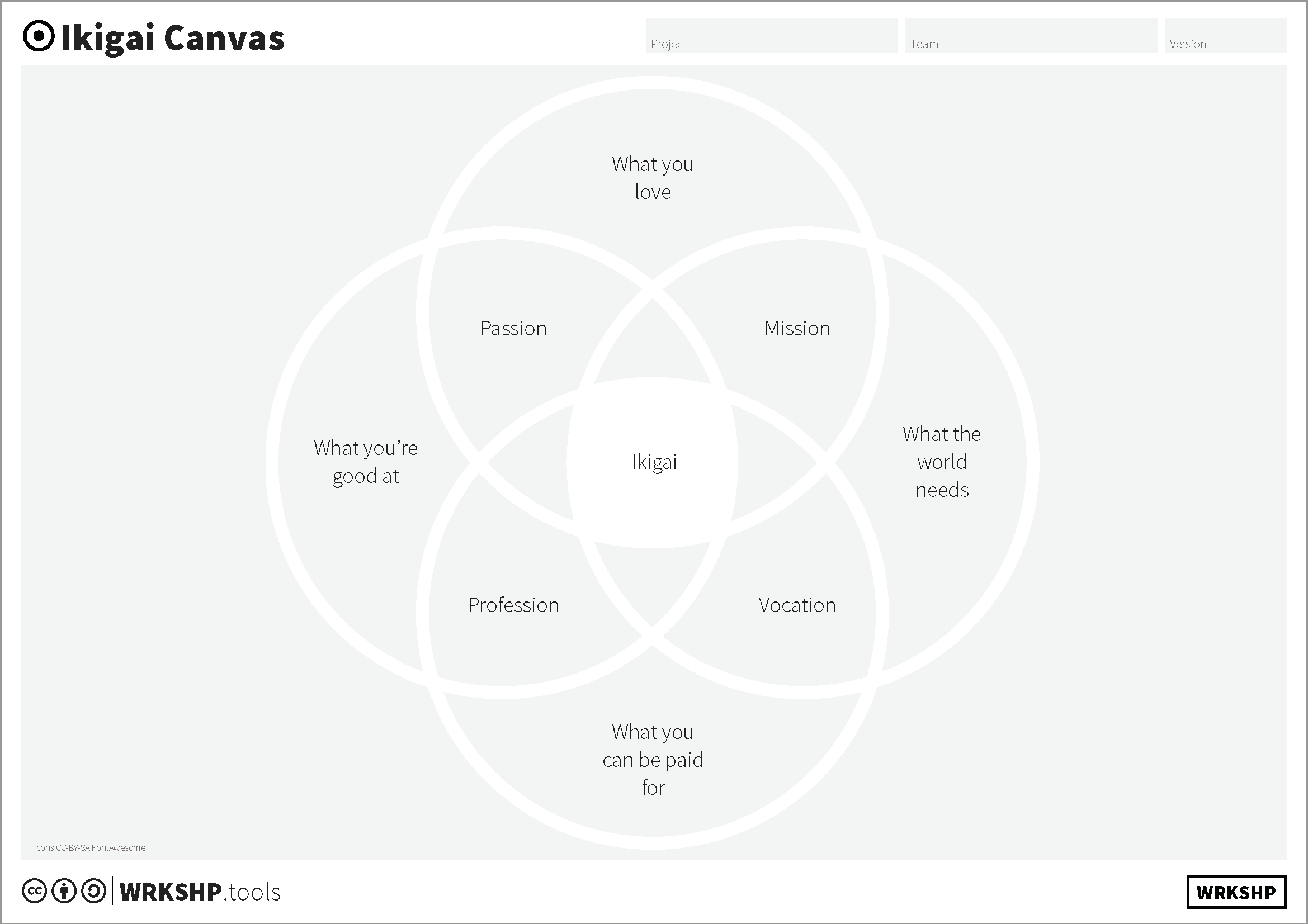Ikigai Canvas
The Ikigai exercise can help you to define your personal perspective, by asking yourself four key questions.
Use this tool when:
- you want to find your purpose.
Overview
| Time | ± 45 minutes | |
| Difficulty | 3 / 5 | |
| People | 3 - 5 | |
| Author | erik van der pluijm | |
| Website | ||
| License | CC BY SA 4.0 |

What is it and when should I use it?
'Ikigai' is Japanese for 'a reason for being', which can be loosely translated as 'purpose'.
The Ikigai exercise can help you to define your personal perspective, by asking yourself four key questions. The questions to answer are: ‘what do you love?’, ‘what are you good at?’, ‘what can you be paid for?’, and ‘what does the world need?’. By answering them and mapping the results in the Ikigai canvas, you see if there are any entries that are closer to the center of the diagram. If there are things you love and are good at, for instance, they end up in the part of the diagram where those two circles overlap. Try to find out if there is anything that you came up with that is the answer to all four questions.
The tool classifies algorithms into five categories:
If you get stuck doing this, simply go over all the different things you have done in your life, plus things you’d love to do, and see where they end up in the circle. Find inspiration in what other people in the world are doing.
Tool Overview

What you’re good at What are you good at? What are skills and talents you have? What do you have experience doing?
What the world needs What are things the world (or people in it) need? What are the problems that need solving?
What you love What do you love to do or experience? What are the things that make you happy?
What you can be paid for What are the things you can make money with? Things you can do or create that you can get paid for?
Your Passion Things that you are good at and love to do are probably things you are passionate about.
Your Mission Things you love to do that are also what the world needs are things you could see as your mission.
Your Profession Things that you are good at and can get paid for are candidates for your profession.
Your Vocation Things you can be paid for that are also what the world needs are your vocation.
Your Ikigai Your ikigai is what is your personal intersection of what you are good at, what the world needs, what you can be paid for, and what you love to do.
Steps
1 Collect
Sit down, and for each of the four outer circles, come up with 3-5 items. If you get stuck, ask yourself: what would somebody else answer about me? Or, simply ask someone that knows you well. Stick these on your canvas.
2 Connect
Try to see if there are any items you already put down that can be placed on the overlap of any of the large circles.
Then, go over the overlapping circles that are still empty and try to see if you can combine items that you already have to fill them. Of course, if you come up with new items that is also fine, just make sure that they are really what you feel and are comfortable with.
3 Ikigai
Try to connect items further until you have something that can be placed in the center. Perhaps you didn't find it yet, if so, go back to step 1 and try to talk to close friends and relatives about what they think you are good at, can make money with, etc.
4 Check
Check your Ikigai, first with yourself. Is this really something that feels right for all four aspects? Is there nothing else that could take its place? If you aren't completely sure, come back to it a few days later and repeat the exercise. Then, check it with close friends and relatives. Do they agree?
5 Next Steps
Keep revisiting your Ikigai. What has changed?